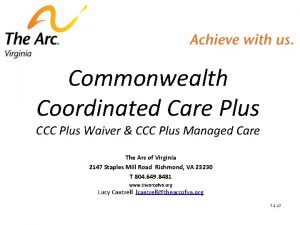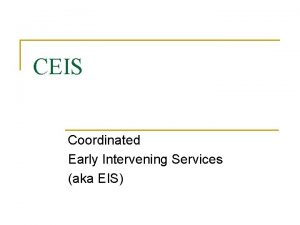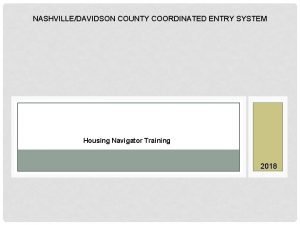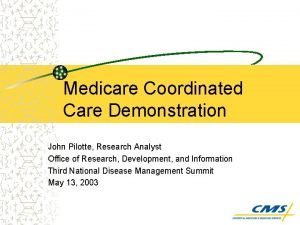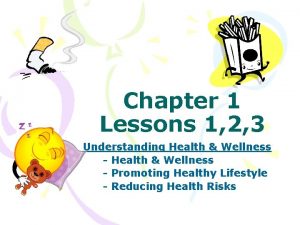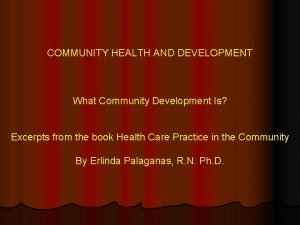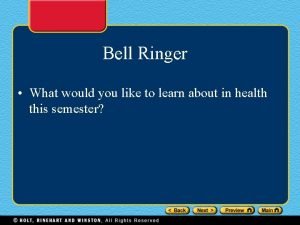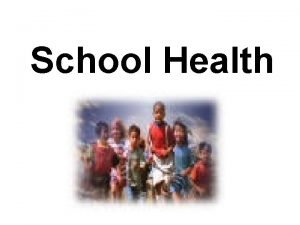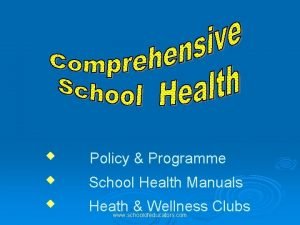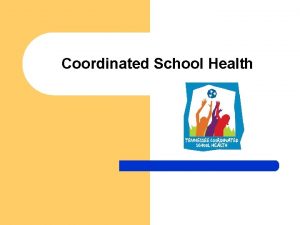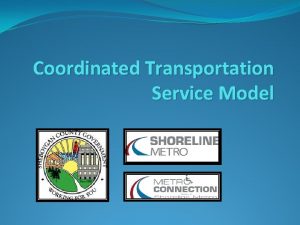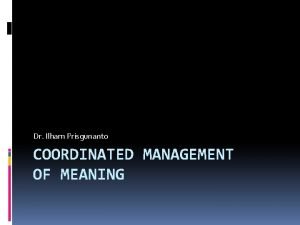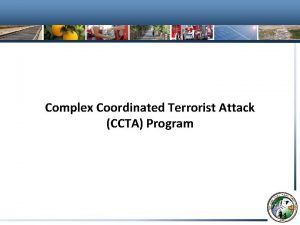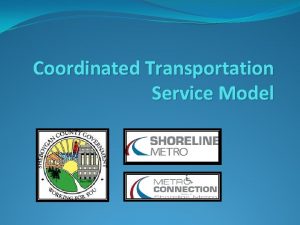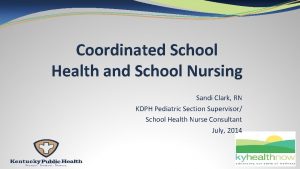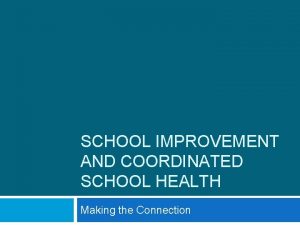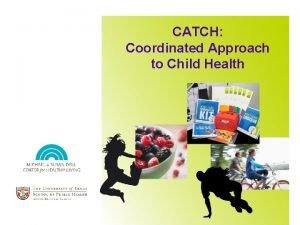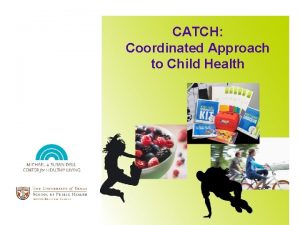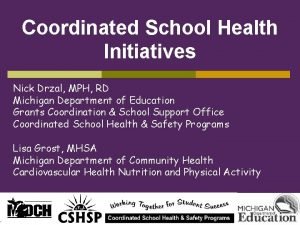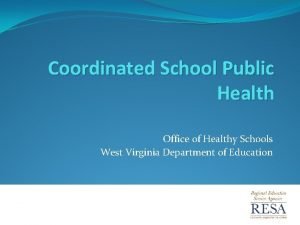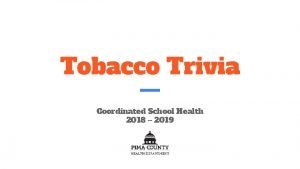Why Coordinated School Health What is Coordinated School




























































- Slides: 60


Why Coordinated School Health? What is Coordinated School Health? Wellness Policies Vending Regulations Regina Ginn Shane Mc. Neill Office of Healthy Schools

Why? If schools do not deal with children’s health by design, they deal with it by default. Health is Academic, 1997

Every day in Mississippi, we have an opportunity to reach… 494, 038 public school students 152 School Districts 618 Elementary Schools/225 Secondary Schools Over 68, 700 adults work as teachers, school building staff, or school district staff

Why Coordinated School Health? It is difficult for students to be successful in school if they are: Depressed Tired Being bullied Stressed Sick Using alcohol or other drugs Hungry Abused

MASLOW’S HEIRARCHY AND COORDINATED SCHOOL HEALTH Health Education Motivated and Learning Physical Education Health Services Sense of Positive Self-Esteem Sense of Belonging and Nutrition Services Counseling, Psychological and Social Services Healthy School Environment Importance Sense of Being Loved and Appreciated Free of Fear and In A Safe place Physical Health Promotion for Staff Family/Community Involvement

Is school health the missing link to school improvement?

Why Coordinated School Health? 6 behaviors account for most of the serious illness and premature deaths in the US Tobacco Use Abuse of alcohol and other drug use Unintentional injuries and violence Sexual Behaviors resulting in HIV, sexually transmitted diseases or teenage pregnancy Poor eating habits Inadequate physical activity

Tobacco Use Youth Risk Behavior Survey Grades 9 -12

Alcohol Abuse Youth Risk Behavior Survey Grades 9 -12

Juvenile Crime Rate Arrest rate of persons under age 18 (per 100, 000 persons age 10 to 17) in Mississippi, US FBI Arrest Statistics

Injury Youth Risk Behavior Survey Grades 9 -12

Results of Poor Eating Habits and Physical Inactivity

Poor Eating Habits and Physical Inactivity 2003 Youth Risk Behavior Survey Grades 9 -12 Behavior MS US YRBSS Insufficient Physical Activity 82% 75% Daily PE Class 23. 4% 28. 4% >3 hrs TV/school 54. 1% day 38. 2% <3 glasses milk/day 89% 82. 9% <5 daily servings fruit/vegetables 80% 78%

Why Coordinated School Health? The alternative is costly Hidden Costs to Schools Measurable Costs to Schools Costs to State

The Hidden Costs Extra staff time needed for students with low academic performance or behavior problems caused by poor nutrition and physical inactivity. Costs associated with time and staff needed to administer medications needed by students with associated health problems. Healthcare costs, absenteeism, and lower productivity due to the effects of poor nutrition, inactivity and overweight among school employees.

Measurable Costs to State (2004 -2005) Statewide Enrollment: 494, 590 ADA Statewide: 472, 577 Statewide Attendance: 95% $4, 193 per student based on fully funded MAEP (2005 -2006) Statewide schools leaving $92, 300, 509 on table (not taking into consideration local contribution)

Measurable Cost to Schools (Example) School District: 3, 000 Students Each 1% attendance improvement = $125, 790

Community Costs “State of Health” in Mississippi Obesity l Diabetes l l # 1 state in the nation in heart disease related deaths In 2004, # 3 state in the nation in stroke related deaths Cancer l # 2 state in the nation in Type II diabetes Cardiovascular Disease l $757, 000 cost per year in MS; $444, 000 paid by Medicare and Medicaid # 5 state in the nation in cancer related deaths Asthma l # 1 reason for school absenteeism in MS

What: Coordinated School Health

Coordinated School Health Program Health Education Family and Community Involvement Physical Education Health Services Health Promotion for Staff Healthy School Environment Nutrition Services Counseling, Psychological Services

Health Education Reading and math scores of third and fourth grade students who received comprehensive health education were significantly higher than those who did not receive comprehensive health education Schoener, Guerrero, and Whitney, 1988

Physical Education Intensive physical activity programs for students led to an improvement in students’ scores in mathematics, reading, and writing and to a reduction in disruptive behaviors in the classroom. Sallis, 1999

Health Services Early childhood and school aged intervention programs that provide parental support and health services are associated with improved school performance and academic achievement. Early intervention may also improve high school completion rates and lower juvenile crime. Reynolds, Temple, Robertson, and Mann, 2001

Nutrition Services School breakfast programs: l Increase learning and academic achievement l Improve student attention to academic tasks l Reduce visits to the school nurse l Decrease behavior problems Murphy, Pagano, Nachmani, Sperling, Kane and Kleinman, 1998 Schools that have eliminated competitive foods and substituted them with nutritious choices report that students’ concentration and behavior improve. Anderson, 2002

Counseling, Psychological and Social Services A school-based social services program targeting students at risk for dropping out of school produced the following results: l l l Grade point average increased across all classes School bonding increased Self-esteem improved Eggert, Thompson, Herting, Nicholas, and Dicker, 1994

Healthy School Environment The physical condition of a school is statistically related to student academic achievement. An improvement in the school’s condition by one category, say from poor to fair, is associated with a 5. 5 point improvement in average achievement scores. Berner, 1993

Health Promotion for Staff Teachers who participated in a health promotion program focusing on exercise, stress management, and nutrition reported: l l l Increased participation in exercise and lower weight Better ability to handle job stress A higher level of general wellbeing Blair, Collingwood, Reynolds, Smith, Hagan and Sterling, 1984

Family/Community Involvement Community activities that link to the classroom: l l l Positively impact academic achievement Reduce school suspension rates Improve school-related behaviors Nettles, 1991 Allen, Philliber, Herring, and Kupermine, 1997


Initiatives Local School Wellness Policy Start Up Grants John D. Bower, M. D. School Health Network The Bower Foundation Vending Machine Case Study Vending Regulations HIV/AIDS Policy Guide for Development HIV/AIDS Prevention Grants Comprehensive Health/P. E. Framework Training Mississippi School Health Successes

Mississippi Local School Wellness Policies and Regulations

Local School Wellness Policy Guide for Development WHY? WHAT? HOW? WHO? WHEN? CHALLENGE TO YOU……. MAKE IT HAPPEN!


Our kids are facing a weight, nutrition, and health crisis.


Mississippi School Wellness Policy Guide for Development

GOALS for nutrition education, physical activity, and other school-based activities that are designed to promote student wellness in a manner that the local education agency determines is appropriate

Nutrition GUIDELINES selected by the local educational agency for ALL foods available on each school campus under the local educational agency during the school day with the objectives of promotion student health and reducing childhood obesity

Assurances that guidelines for reimbursable school meals are not less restrictive than the regulations issued by the USDA

Ways of measuring how well the school wellness policy is being implemented, including designation of one or more persons at each school with operational responsibility for ensuring that the school is meeting the policy

Involvement of parents, students, representatives of the school food authority, the school board and school administrators, and the public, in developing the wellness policy


Three Steps for Success 1. 2. 3. Gather input and assess current situation. Develop and approve a school wellness policy. Implement an effective school wellness policy.

A team approach … ü ü ü ü ü Students Families Teachers Coaches Nurses Counselor Principal Superintendent Foodservice staff After-school staff ü ü ü ü ü Doctor Dietitian Therapist Dentist School Attendance Officer Public Health YWCA/YMCA Boys/Girls Club Extension College/University

Mississippi School Health Councils by 11/06


YOU are natural leaders for


School wellness policies are required beginning in 2006.

Child Nutrition and WIC Reauthorization Act of 2004

Vending Machine Case Study Objectives – SY 2005 -2006 Change beverage choices in vending machines at school Assess financial impact Identify approaches l Healthful beverages available l Maintain school profits

Schools Selected for SY 2005 -2006 Desoto County Hernando Middle School Olive Branch High School Tishomingo County High School Bolivar County West Bolivar Junior High School West Bolivar High School Hinds County Union County West Union Attendance Center Ingomar Attendance Center Raymond High School Utica Elementary Middle School Bolton Edwards Elementary Middle School Pearl River County Picayune Junior High School Picayune Memorial High School Harrison County Gulfport High School Gulfport Central Middle School Bayou View Middle School Simpson County Mendenhall Junior High School Forrest County Hattiesburg High School Burger Middle School

PROPOSED School Vending Regulations

PROPOSED Regulations What do kids need to have AT SCHOOL?

Beverage Regulations Considered for approval at the Sept. 2006 State Board Meeting

Snack Regulations Out for Public Comment until September 15

Former Surgeon General Dr. Antonio Novello “Health and education go hand in hand: one cannot exist without the other. To believe any differently is to hamper progress. Just as our children have a right to receive the best education available, they have a right to be healthy. As parents, legislators, and educators, it is up to us to see that this becomes a reality. ” Healthy Children Ready to Learn: An Essential Collaboration Between Health and Education, 1992

Coordinated School Health Make it a reality in your school!!

Resources © 2002 Association of State and Territorial and Health Officials (ASTHO) and The Society of State Directors of Health, Physical Education and Recreation (SSDHPER) www. thesociety. org Mississippi Department of Education www. mde. k 12. ms. us Youth Risk Behavior Survey www. mde. k 12. ms. us/Healthy. Schools/Resources. html Center for Disease Control www. cdc. gov/healthyyouth/ State Juvenile Justice Profiles www. ncjj. org
 Hey hey bye bye
Hey hey bye bye Alabama coordinated health network
Alabama coordinated health network Don't ask why why why
Don't ask why why why A consciously coordinated social unit
A consciously coordinated social unit Serpentine model cmm
Serpentine model cmm 211 snohomish county
211 snohomish county Barbara paradiso
Barbara paradiso Coordinated management of meaning examples
Coordinated management of meaning examples Cccplusva
Cccplusva Chicago central referral system
Chicago central referral system Introduction of retail management
Introduction of retail management Coordinated effort in retailing concept
Coordinated effort in retailing concept Coordinated early intervening services
Coordinated early intervening services Early intervening services
Early intervening services A series of coordinated related multiple projects
A series of coordinated related multiple projects A series of coordinated related multiple projects
A series of coordinated related multiple projects Modern project management
Modern project management Coordinated product and supply chain design
Coordinated product and supply chain design Chapter 1 modern project management
Chapter 1 modern project management Coordinated entry
Coordinated entry Wco 10 building blocks
Wco 10 building blocks Housing navigator training
Housing navigator training A series of coordinated related multiple projects
A series of coordinated related multiple projects A series of coordinated related multiple projects
A series of coordinated related multiple projects John pilotte cms
John pilotte cms All india coordinated research project
All india coordinated research project Coordinated plan on ai
Coordinated plan on ai Coordinated engagements
Coordinated engagements Why-why analysis
Why-why analysis Wh tongue twister
Wh tongue twister Does this table represent a function why or why not
Does this table represent a function why or why not What does a table represent
What does a table represent Why or why not
Why or why not Contoh laporan root cause analysis
Contoh laporan root cause analysis Health triangle social
Health triangle social Why is health education important
Why is health education important Key issue 3 why do some places face health challenges
Key issue 3 why do some places face health challenges Why is your health triangle like a carousel?
Why is your health triangle like a carousel? Purpose of home visiting in community health nursing
Purpose of home visiting in community health nursing Roles of occupational health nurse
Roles of occupational health nurse National program for mother and child
National program for mother and child Louisiana health standards
Louisiana health standards Difference between health and health education
Difference between health and health education Whole health circle of health
Whole health circle of health Health and social care component 3 health and wellbeing
Health and social care component 3 health and wellbeing Health maintenance and promotion
Health maintenance and promotion Pet 3351 ucf
Pet 3351 ucf Chapter 3 health wellness and health disparities
Chapter 3 health wellness and health disparities Difference between health education and health propaganda
Difference between health education and health propaganda Glencoe health chapter 1 understanding health and wellness
Glencoe health chapter 1 understanding health and wellness Understanding health and wellness chapter 1
Understanding health and wellness chapter 1 Optimal health in each of the six components of health
Optimal health in each of the six components of health Who invented lewis dot structure
Who invented lewis dot structure Fictional character chap 1
Fictional character chap 1 My first free summer by julia alvarez
My first free summer by julia alvarez Why is attending school important
Why is attending school important Definition of school health
Definition of school health School health programme
School health programme School health committee members
School health committee members School health club manual
School health club manual Monash university master of public health
Monash university master of public health








